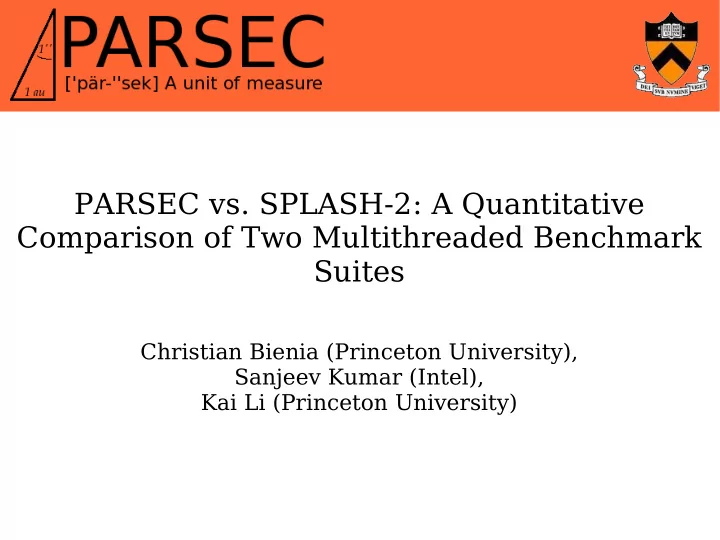

PARSEC vs. SPLASH-2: A Quantitative Comparison of Two Multithreaded Benchmark Suites Christian Bienia (Princeton University), Sanjeev Kumar (Intel), Kai Li (Princeton University)
Outline ● Overview – What is PARSEC? – Why a new benchmark suite? ● Objectives of PARSEC – Technology Trend 1: Proliferation of CMPs – Technology Trend 2: Change of Technology Constraints – Technology Trend 3: Growth of World Data ● Characteristics Analysis – Methodology – Results ● Conclusions
What is PARSEC? ● Princeton Application Repository for Shared- Memory Computers ● Benchmark Suite for Chip-Multiprocessors ● Started as Joint-Venture between Intel and Princeton University ● Freely available at: http://parsec.cs.princeton.edu/ ● You can use it for your research But what distinguishes PARSEC from SPLASH-2?
Requirements for a Benchmark Suite for CMPs ● Multithreaded Applications Future programs must run on multiprocessors ● Emerging Workloads Increasing CPU performance enables new applications ● Diverse Multiprocessors are being used for more and more tasks ● State-of-Art Techniques Algorithms and programming techniques evolve rapidly ● Support Research Our goal is insight, not numbers
Assessment of Situation Multithreaded Emerging Not HPC- Diverse Research Workloads Focused SPEC CPU2006 No No Yes No No Yes No Yes No No SPEC OMP2001 Yes No Yes No Yes SPLASH-2 Yes Yes No Yes Yes ALPBench No No No No Yes BioBench Yes No No No Yes BioParallel No No No Yes Yes MediaBench II Yes No No Yes Yes MineBench 2.0 Yes Yes No Yes Yes PhysicsBench This is why we created PARSEC
Workloads Program Application Domain Parallelization Blackscholes Financial Analysis Data-parallel Bodytrack Computer Vision Data-parallel Canneal Engineering Unstructured Dedup Enterprise Storage Pipeline Facesim Animation Data-parallel Ferret Similarity Search Pipeline Fluidanimate Animation Data-parallel Freqmine Data Mining Data-parallel Streamcluster Data Mining Data-parallel Sw aptions Financial Analysis Data-parallel Vips Media Processing Data-parallel X264 Media Processing Pipeline PARSEC is substantially different from SPLASH-2
Outline ● Overview – What is PARSEC? – Why a new benchmark suite? ● Objectives of PARSEC – Technology Trend 1: Proliferation of CMPs – Technology Trend 2: Change of Technology Constraints – Technology Trend 3: Growth of World Data ● Characteristics Analysis – Methodology – Results ● Conclusions
Objectives of PARSEC ● PARSEC was designed to capture recent technology trends: – Proliferation of CMPs Multiprocessors are used in more and more areas – Change of Technology Constraints Different software optimizations required for CMPs – Growth of World Data Huge increase of stored data which must be processed ● These trends are changing programs
Impact of Technology Trends ● Proliferation of CMPs: – New application areas (e.g. video games) – New parallelization models (e.g. pipelining) ● Change of Technology Constraints: – Constrained off-chip bandwidth – Shared caches ● Growth of World Data: – Huge increase of input data – Higher importance of linear algorithms We show that these trends affect program characteristics
Outline ● Overview – What is PARSEC? – Why a new benchmark suite? ● Objectives of PARSEC – Technology Trend 1: Proliferation of CMPs – Technology Trend 2: Change of Technology Constraints – Technology Trend 3: Growth of World Data ● Characteristics Analysis – Methodology – Results ● Conclusions
Methodology ● Simulate abstract cache ● 44 characteristics chosen: hierarchy with CMP$im – Instruction mix ● Preprocess chosen (4 characteristics) characteristics with – Working set Principal Component (8 characteristics) Analysis (PCA) to – Sharing eliminate correlation (32 characteristics) ● Compute similarity with hierarchical clustering ● Visualize results with dendrograms and scatter plots
Redundancy & Similarity Clustering Clustering within of SPLASH-2 Unique Workloads
Redundancy & Similarity Clustering Clustering within of SPLASH-2 Unique Workloads
Redundancy & Similarity PARSEC is more diverse than SPLASH-2
Systematic Differences Benchmark suites cluster in different areas, little overlap PARSEC SPLASH-2 PARSEC and SPLASH-2 have little in common
Instruction Mix Differences PARSEC SPLASH-2 PARSEC workloads use cores differently
Working Set Differences PC 1 PARSEC SPLASH-2 Some PARSEC workloads use memory differently
Sharing Behavior Differences PARSEC SPLASH-2 PARSEC workloads communicate differently
Outline ● Overview – What is PARSEC? – Why a new benchmark suite? ● Objectives of PARSEC – Technology Trend 1: Proliferation of CMPs – Technology Trend 2: Change of Technology Constraints – Technology Trend 3: Growth of World Data ● Redundancy & Similarity – Methodology – Results ● Conclusions
Conclusions ● PARSEC and SPLASH-2 are substantially different benchmark suites ● PARSEC is more diverse ● No single reason for differences You should expect different results
Thank you! Questions?
Recommend
More recommend